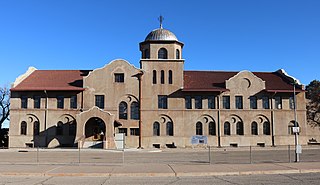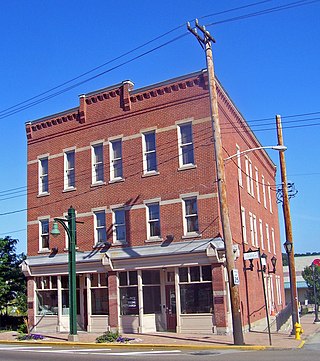
Pueblo is a home rule municipality that is the county seat and the most populous municipality of Pueblo County, Colorado, United States. The city population was 111,876 at the 2020 United States Census, making Pueblo the ninth most populous city in Colorado. Pueblo is the principal city of the Pueblo, CO Metropolitan Statistical Area and a major city of the Front Range Urban Corridor.

Mesa Verde Administrative District is a set of six National Park Service buildings within Mesa Verde National Park, constructed between 1921 and 1927 in the Pueblo Revival style. Located on Chapin Mesa, these were the structures built by the Park Service to use culturally relevant architectural traditions in park architecture. The buildings were declared a National Historic Landmark District in 1987.

The Colorado Fuel and Iron Company (CF&I) was a large steel conglomerate founded by the merger of previous business interests in 1892. By 1903 it was mainly owned and controlled by John D. Rockefeller and Jay Gould's financial heirs. While it came to control many plants throughout the country, its main plant was a steel mill on the south side of Pueblo, Colorado and was the city's main industry for most of its history. From 1901 to 1912, Colorado Fuel and Iron was one of the Dow Jones Industrials. The steel-market crash of 1982 led to the decline of the company. After going through several bankruptcies, the company was acquired by Oregon Steel Mills in 1993, and changed its name to Rocky Mountain Steel Mills. In January 2007, Rocky Mountain Steel Mills, along with the rest of Oregon Steel's holdings, were acquired by EVRAZ Group, a Russian steel corporation, for $2.3 billion.

The Eggerss–O'Flyng Building is located at 801 South 15th Street in downtown Omaha, Nebraska, United States. The building was listed on the National Register of Historic Places in 1991, and named an Omaha Landmark on March 17, 1992.

The Bost Building, also known as Columbia Hotel, is located on East Eighth Avenue in Homestead, Pennsylvania, United States. Built just before the 1892 Homestead Strike, it was used as headquarters by the Amalgamated Association of Iron and Steel Workers and for reporters covering the confrontation. It is the only significant building associated with the strike that remains intact. It is a contributing property to the Homestead Historic District. It was declared a National Historic Landmark in 1999.

The Steelworks Museum is located in Pueblo, Colorado. Operated by the Steelworks Center of the West, the museum is in the historic Minnequa Steel Works Office Building and Dispensary of the Colorado Fuel and Iron Company.
South Pueblo, Colorado used to be a city in Colorado. It was one of three towns, in addition to Central Pueblo and Bessemer, that were later incorporated into Pueblo, Colorado.
Bessemer, Colorado was a city in Colorado that was incorporated in 1886. The community was named after Henry Bessemer, an English inventor. It was one of four adjacent towns settled after the Colorado Gold Rush of 1859. The communities of South Pueblo, Central Pueblo, Pueblo, and Bessemer were later merged to create the modern City of Pueblo, Colorado. Bessemer was an independent city until 1894 and was the last city to join Pueblo. The former community of Bessemer is sometimes now referred to as the Bessemer neighborhood. Its also known as the Bessemer area. The Bessemer area is home to both Bessemer Academy and Bessemer park.
Colorado Coal and Iron Company was formed in 1880 when three Denver and Rio Grande subsidiaries controlled by William J. Palmer merged. These were the Colorado Coal and Steel Works Company, the Central Colorado Improvement Company, and the Southern Colorado Coal and Town Company. In 1888, Edward J. Berwind was president. In 1890 the company appointed Henry S. Grove to serve as president. Grove, a recognized "Captain of Industry" would eventually merge the company with the Colorado Fuel Company to form the Colorado Fuel & Iron Company, which for many years was Colorado's largest employer and dominated industry around the state for decades.
Frederick Sterner (1862–1931) was a British-born American architect, who designed large residential and commercial buildings in Colorado and New York City. Many of his structures are listed on the National Register of Historic Places.

John Cleveland Osgood was a self-made man who founded the Colorado Fuel and Iron Company and Victor-American Fuel Company but has been referred to as a robber baron. He also created Redstone, Colorado.

Sunrise was a company mining town of the Colorado Fuel and Iron Company located in Platte County, Wyoming, United States. The entire site of the former mining district and town is listed on the National Register of Historic Places.

The Flintridge Building is a historic office building in Fairfield, Alabama, in metropolitan Birmingham. From 1951 to 1964 it served as the headquarters of the southern division of United States Steel and housed nearly 1,500 employees. In 2004 the building was added to the National Register of Historic Places.

Midwest Steel & Iron Works was a metal fabrication company based in Denver, Colorado. Founded in 1893, the company was known for a time as the Jackson-Richter Iron Works. The company was one of the "oldest and largest metal fabricators" in Denver. The company built both structural and ornamental components for structures throughout Colorado, Wyoming, and New Mexico. The company's headquarters on Larimer Street in Denver includes an Art Deco office building and consists of a four-building complex that is itself considered a historic industrial site. The complex served as the company's headquarters from 1923 to 1983.

The Lukens Main Office Building is an historic office building which is located in Coatesville, Chester County, Pennsylvania, USA.

The Steelworks Center of the West, is a non-profit organization focused on preserving the history of the coal and steel industry in the Western United States. Based in Pueblo, Colorado and formerly known as the Bessemer Historical Society, which took its name from the community of Bessemer, site of the Colorado Coal and Iron Bessemer Works which was named after the Bessemer process for making steel invented by Henry Bessemer.

St. Mary-Corwin Medical Center is a medical facility with a Flight For Life base, cancer and stroke center and residency program located in Pueblo, Colorado. It is a part of the Centura Health Network. It specializes in orthopedics, cancer care, emergency services, robot-assisted surgery, breast care and women's services.

Primero is a ghost town in Las Animas County, Colorado, United States. The community was a company coal mining town for the Colorado Fuel and Iron Company during the early 20th century.

Tercio is a ghost town and former coal mine in Las Animas County, in the U.S. state of Colorado. The GNIS classifies it as a populated place. A post office called Tercio was established in 1902, and remained in operation until 1949. The community was the third coal mining community established by the Colorado Fuel and Iron company, hence the name.

The Ohio Oil Company Building, at 159 N. Wolcott St. in Casper, Wyoming, was built in 1949. Also known as the Marathon Oil Company Building, it was listed on the National Register of Historic Places in 2001.















